Alcatel Internetworking OA3530-S WWAN Laptop PCMCIA Card User Manual OANLG 1 2 EndUserRef 1 2 203
Alcatel Internetworking, Inc WWAN Laptop PCMCIA Card OANLG 1 2 EndUserRef 1 2 203
User Manual

OmniAccess 3500
Nonstop Laptop Guardian
Release 1.2
End-User Reference Guide
Document Version: 1.2.203
Part Number: 060226-10 Rev A
Published: 09.17.2007
Alcatel-Lucent Proprietary
Copyright © 2007 Alcatel-Lucent. All rights reserved. This document may not be
reproduced in whole or in part without the express written permission of Alcatel-
Lucent. Alcatel-Lucent ® and the Alcatel-Lucent logo are registered trademarks of
Alcatel-Lucent. All other trademarks are the property of their respective owners.
Table of Contents
Welcome...........................................................................................1
OmniAccess 3500 NLG Card Features Overview .............................................1
Common Operations .............................................................................1
How do I get started? .........................................................................1
OmniAccess 3500 NLG Client window menu options...................................2
OmniAccess 3500 NLG Client window sections .........................................3
How do I connect to the company network?..............................................3
How do I manually change my serving network interface? .............................4
How do I select my roaming and network preferences?.................................4
How do I connect from a public hotspot?..................................................5
Ho do I view the status of my remote access connection?..............................6
How do I view the status of my 3G access connection? .................................6
How do I update the profile of my 3G data subscription? ..............................7
How do I manage my personal firewall? ...................................................8
Allowing an application through the firewall...........................................8
Viewing personal firewall settings........................................................9
Removing an application from the firewall list ........................................9
How do I secure my sensitive data? ...................................................... 10
What if my laptop is lost or stolen? ...................................................... 10
How do I extract the card from my laptop?............................................. 12
How do I get help?........................................................................... 12
Technical Specifications ...................................................................... 13
LED Specifications........................................................................... 13
Radio Frequency and Electrical Specifications ......................................... 13
Environmental and Mechanical Specifications.......................................... 14
Regulatory Information........................................................................ 14
Regulatory Notices .......................................................................... 14
Safety and Notices ............................................................................. 16
Important Notice ............................................................................ 16
Safety and Hazards.......................................................................... 16
OmniAccess 3500 Nonstop Laptop Guardian End-User Reference Guide
1
Welcome
Welcome to the OmniAccess 3500 Nonstop Laptop Guardian — Release 1.2 — End-User
Reference Guide. This guide will introduce you to the many functions of the
OmniAccess 3500 Nonstop Laptop Guardian (NLG) card and their operation.
For instructions on how to install your card and the client software, see the
OmniAccess 3500 Nonstop Laptop Guardian — Release 1.2 — Card Quick Start Guide.
OmniAccess 3500 NLG Card Features Overview
The OmniAccess 3500 NLG card keeps your laptop within the security perimeter of
your company’s network at all times, irrespective of where you are.
The card supports the following functions:
• Secure connectivity with your company’s network irrespective of your laptop’s
location and with no action required on your part.
• Automatic switching of network interface serving the connection to your
company’s network when the current serving interface (e.g., wired Ethernet) is
disconnected.
• Easy manual switching of network interface serving the connection to your
company’s network when the laptop senses a surrounding access network with
better performance.
• Integrated Personal Firewall to protect your laptop from attackers and to restrict
the set of applications that are allowed to access the network.
• Encrypted volume for storage of sensitive data in your laptop’s hard disk.
Configuration and management of the encrypted volume are fully transparent to
you (no passwords to enter and maintain).
• Protection of the data stored in your laptop in case it is lost or stolen. Your IT
administrator can remotely lock the laptop or destroy the keys that are required
for decryption of the encrypted volume contents.
• Integration of common patch management applications (Microsoft SMS, PatchLink
Update) to take the execution of time-consuming patch downloads away from
the hours when you typically work with your laptop.
Common Operations
The following sections show you how to perform basic OmniAccess 3500 NLG
operations on the graphical user interface (GUI) of the OmniAccess 3500 NLG client.
How do I get started?
The client GUI is accessible on your laptop after you have successfully installed the
OmniAccess 3500 NLG card (see the OmniAccess Nonstop Laptop Guardian — Release
1.2 — Card Quick Start Guide for installation instructions).
You can open the OmniAccess 3500 NLG client GUI in one of the following ways:
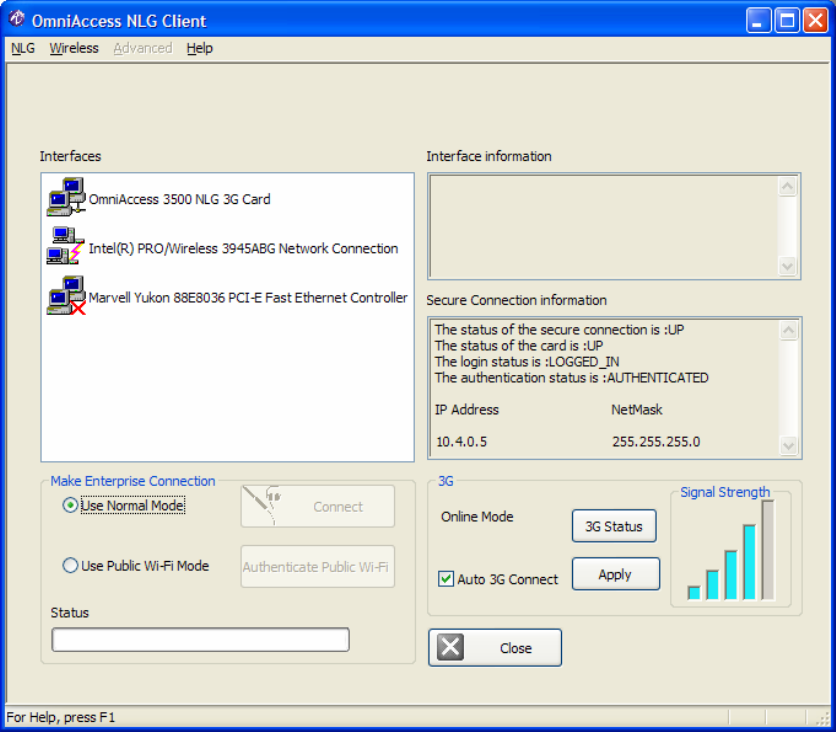
OmniAccess 3500 Nonstop Laptop Guardian End-User Reference Guide
2
• Double-click on the OmniAccess 3500 NLG desktop icon.
• Double-click on the OmniAccess 3500 NLG tray icon.
• Click Start -> Programs -> OmniAccess 3500 NLG Client Programs -> Alcatel-
Lucent -> OmniAccess 3500 NLG -> OmniAccess 3500 NLG Client.
The OmniAccess 3500 NLG Client window appears.
OMNIACCESS 3500 NLG CLIENT WINDOW MENU OPTIONS
The menu bar at the top of the OmniAccess 3500 NLG Client window contains the
following menus:
• NLG — Manage the OmniAccess 3500 NLG client. Available options:
− Show: Display the main window of the client GUI.
− Configure: Configure certificate files and user key.
− Personal Firewall Settings: Manage the personal firewall settings on the
OmniAccess 3500 NLG card.
− Close: Hide the GUI window.
• Wireless — Manage the 3G wireless subscription. Available options:
OmniAccess 3500 Nonstop Laptop Guardian End-User Reference Guide
3
− Modem Activation: Activate the 3G modem.
− Update Data Profile: Update the wireless parameters in the 3G modem.
− Preferences: Configure roaming and network modes.
• Advanced — This menu is not active (grayed out).
• Help — Access help documentation.
OMNIACCESS 3500 NLG CLIENT WINDOW SECTIONS
The OmniAccess 3500 NLG Client window contains the following sections:
• The Interfaces section lists all network interfaces that are available for access
connectivity. A red lightning bolt symbol is added to the icon of the network
interface that currently serves the access connection. A red diagonal cross
symbol is added to the icons of the available network interfaces that are
currently not serving the access connection. You can view configuration and
status information for an interface by clicking on the corresponding icon.
• The Interface Information section displays information about the interface that
is currently highlighted in the Interfaces section.
• The Secure Connection Information section displays parameters for the VPN
tunnel (if established) and the authentication status of the end user.
• The Make Enterprise Connection section provides access to the controls that are
required to connect to your company’s network, including the manual selection
of the serving interface.
• The 3G section provides control for and information about the 3G modem that is
integrated in the OmniAccess 3500 NLG card.
How do I connect to the company network?
If your OmniAccess 3500 NLG card has been properly activated and configured and at
least one of the network interfaces has connectivity to the Internet, the OmniAccess
3500 NLG will automatically connect you to your company’s network over a secure
tunnel. The Interfaces section of the client GUI window will show the red lightning
bolt symbol next to the interface that is currently serving the network connection.
Be sure that you are logged into your laptop with the user ID and password (NT Domain
credentials) provided by your IT administrator for access to your company’s network.
If you use a different set of credentials to log into your laptop, you will see the
lightning bolt symbol but you will have no access to your company’s network.
Depending on network conditions, access to your company’s network may not be
immediately available after you log into your laptop. The appearance of the lightning
bolt symbol will indicate when the secure tunnel to your company’s network is
established.
After your laptop boots up, one of the following three network interfaces, in the order
of priority given below, is used for establishing a connection:
1. Ethernet on your laptop
2. Wi-Fi on your laptop
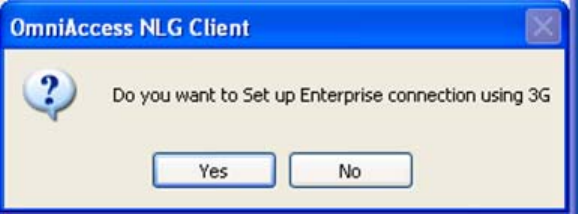
OmniAccess 3500 Nonstop Laptop Guardian End-User Reference Guide
4
3. 3G wireless on your OmniAccess 3500 NLG card
A lower-priority interface is used if no connectivity is available for the higher-priority
one(s).
Once a connection has been established, the serving interface does not change unless
the corresponding access network becomes unavailable (in which case the OmniAccess
3500 NLG automatically establishes a new connection over the available access
network with the highest priority) or you switch it manually.
How do I manually change my serving network interface?
If you are connected to your company’s network through the 3G modem on your
OmniAccess 3500 NLG card and a Wi-Fi access point or an Ethernet outlet become
available near you, you may want to switch your serving interface to experience faster
network access. To manually switch from one interface to another, simply select the
desired interface in the Interfaces section of the OmniAccess 3500 NLG Client window
and click Connect in the Make Enterprise Connection section. The Status bar will show
the progress in the establishment of the new connection.
If you do not want the OmniAccess 3500 NLG to automatically use the 3G connection
(for example, because your 3G service provider charges you based on traffic), uncheck
the Auto 3G Connect checkbox in the 3G section of the OmniAccess NLG Client
window, then click Apply. If the system subsequently needs to connect via 3G, the
following pop-up window appears:
Click Yes or No, depending on whether you want to use the 3G interface to connect to
your company’s network.
Note: The setting of the Auto 3G Connect checkbox is overridden when the 3G
connection is initiated by the OmniAccess 3500 NLG gateway (at times when the
laptop may be powered off or not already connected to the gateway).
How do I select my roaming and network preferences?
To avoid paying the extra connectivity fees that wireless service providers different
than yours may charge when you roam through their networks (being attached to a
visited network instead of your home network), you can prevent your 3G modem from
connecting to a visited network by disabling its roaming capability. You can also
prevent your modem from attaching to low-bandwidth 2G wireless networks.
To select your preferred roaming and networking modes, do the following:
1. On the OmniAccess 3500 NLG Client window, from the Wireless menu, click
Preferences. The Preferences window appears.
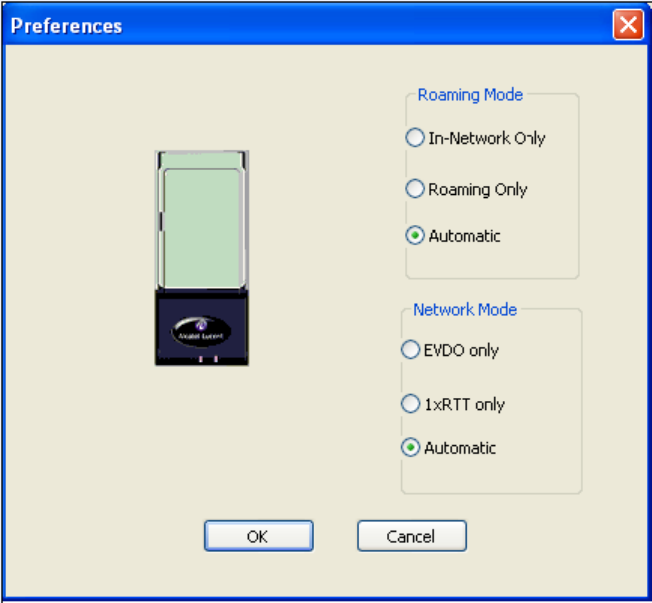
OmniAccess 3500 Nonstop Laptop Guardian End-User Reference Guide
5
2. In the Roaming Mode section of the window, select In-Network Only (to exclude
attachment to a visited network), Roaming Only (to exclude attachment to the
home network), or Automatic (to keep both options available).
3. In the Network Mode section, select EVDO Only (for exclusive 3G connectivity),
1xRTT Only (for exclusive 2G connectivity), or Automatic (for keeping both
options available).
4. Click OK for these settings to become effective.
Note: The Roaming Mode and Network Mode settings are overridden when the 3G
connection is initiated by the OmniAccess 3500 NLG gateway (at times when the
laptop may be powered off or not already connected to the gateway).
How do I connect from a public hotspot?
Wi-Fi access points and Ethernet outlets in hotels and other public places often
require you to enter additional credentials (for example, a local user ID and password
or your credit card information) before granting network access. Since the OmniAccess
3500 NLG cannot know in advance the type of access negotiation implemented at
every such place, you will be required to interactively submit your local access
credentials.
To establish connectivity from a location that requires the submission of local-access
credentials, you must complete the following procedure within the time allowed by
your IT administrator (e.g., five minutes):
1. Click Authenticated Network Access Mode on the Make Enterprise Connection
area of the OmniAccess 3500 NLG Client window.

OmniAccess 3500 Nonstop Laptop Guardian End-User Reference Guide
6
2. Click Authenticate. A browser window opens, asking you to enter the information
required to access the public network (the OmniAccess 3500 NLG automatically
takes care of the proxy settings for your browser upon entering/exiting this
connectivity scenario).
3. After you enter the required information, the OmniAccess 3500 NLG can establish
the secure tunnel to your company’s network through the public network.
Ho do I view the status of my remote access connection?
You can visually recognize the current status of your connection to your company’s
network by looking at the OmniAccess 3500 NLG icon in your laptop’s icon tray.
A purple icon indicates that you are currently logged into your company’s network. A
yellow icon indicates that the VPN tunnel to your company’s is available, but you have
no access to the network. A red icon indicates that the VPN tunnel to your company’s
network is not available.
By rolling the mouse pointer over the icon, you can display explicit information about
the current status of your card, access connection, VPN tunnel, and network
authentication.
The icon will be blinking (in any of the three states described above) when the laptop
is working unguarded, under the effect of the One-Time-Password (see the What if my
laptop is lost or stolen? section below).
How do I view the status of my 3G access connection?
You can view the status of your 3G access connection by clicking 3G Status on the
OmniAccess 3500 NLG Client window. The 3G Card Properties window appears,
showing detailed information about the 3G functionality of your OmniAccess 3500 NLG
card.
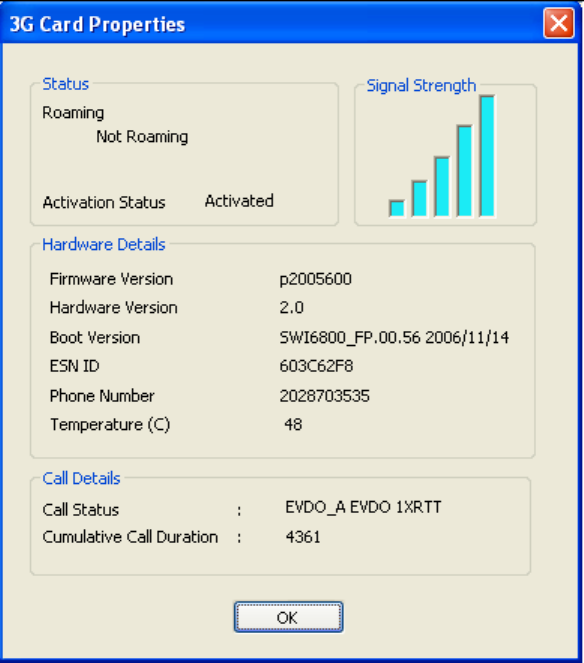
OmniAccess 3500 Nonstop Laptop Guardian End-User Reference Guide
7
How do I update the profile of my 3G data subscription?
It is recommended that you periodically update the data profile of your 3G
subscription through an iOTA session (you should contact your 3G service provider for a
recommended update schedule).
To update the profile, perform the following procedure:
1. On the OmniAccess 3500 NLG Client window, open the Wireless menu and click
Update Data Profile. The Update Data Profile window appears.
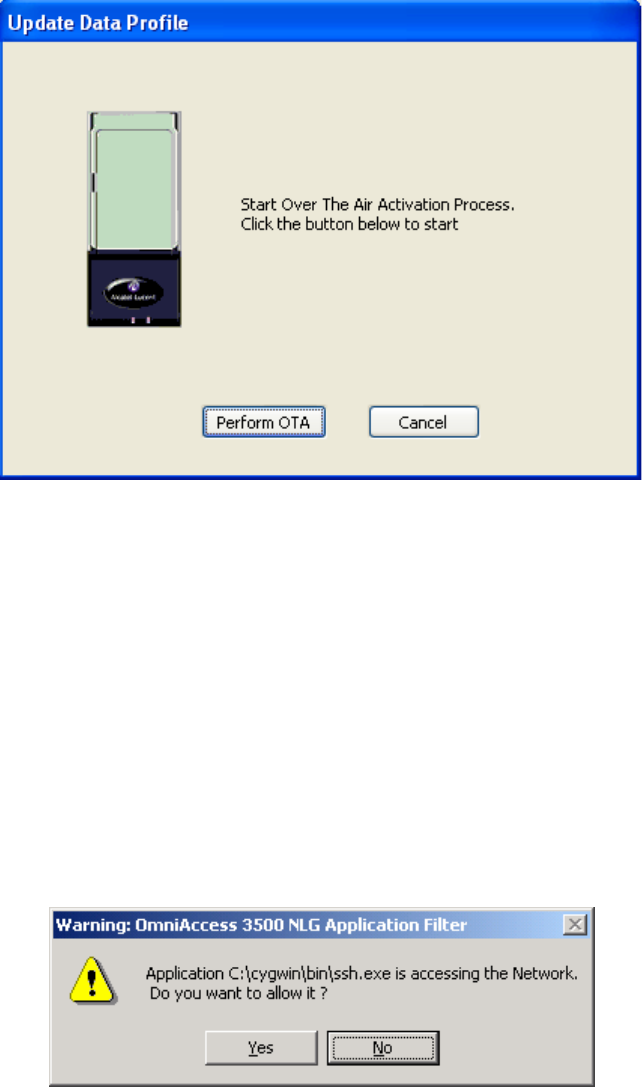
OmniAccess 3500 Nonstop Laptop Guardian End-User Reference Guide
8
2. Click Perform OTA. The 3G wireless parameters inside the 3G modem will be
updated.
How do I manage my personal firewall?
ALLOWING AN APPLICATION THROUGH THE FIREWALL
The personal firewall that resides in your OmniAccess 3500 NLG card may prevent
some applications in the laptop from opening network connections. However, a setting
in your personal firewall policy may allow you to override the default decision of the
personal firewall.
If so configured, an OmniAccess 3500 NLG Application Filter window pops up on the
laptop screen every time the personal firewall detects an attempt to open a network
connection by one of your applications. The window offers you the option to allow
(click Yes) or deny (click No) the network connection.
The personal firewall will remember your answer for all future attempts to open a
network connection by the same application. If you want to change your decision for
the application, you need to remove the application from the list of applications for
which the personal firewall has a set allow/deny policy (see the instructions in the
Removing an application from the firewall list section below). The next time the
application tries to open a network connection, you will be asked again if you want to
allow or deny the connection request.
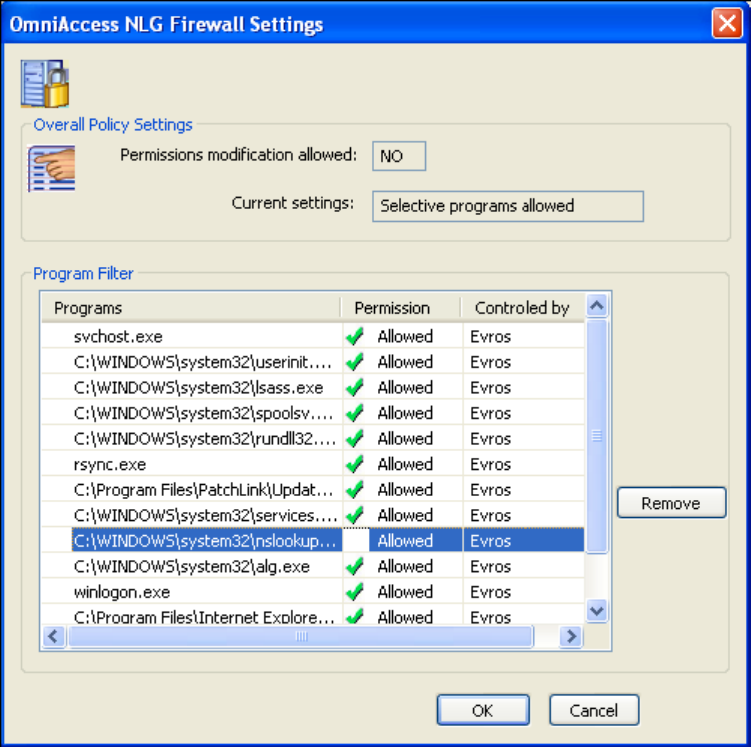
OmniAccess 3500 Nonstop Laptop Guardian End-User Reference Guide
9
VIEWING PERSONAL FIREWALL SETTINGS
The Personal Firewall Settings option in the NLG menu opens a window with the list
off all the applications running on your laptop for which the personal firewall has a set
allow/deny rule.
REMOVING AN APPLICATION FROM THE FIREWALL LIST
You can delete an application from the list of applications that are allowed or denied
through the personal firewall, provided that you have permission to do so. You have
permission to manage the handling of the application in the personal firewall if the
<User> value is shown next to the application in the “Controlled by” column. The
<User> value can only be found next to applications for which you have been
previously asked for an allow/deny decision. Your personal firewall policy may prevent
you from ever making the decision about any application.
To remove an application from the personal firewall list:
1. On the OmniAccess 3500 NLG Client window, open the NLG menu and click
Personal Firewall Settings. The OmniAccess 3500 NLG Firewall Settings window
appears.
OmniAccess 3500 Nonstop Laptop Guardian End-User Reference Guide
10
2. Click an application to highlight it and then click Remove. If you have the
necessary permission, the personal firewall removes the application from the list
of applications with set allow/deny rule. You will be asked to set the rule again
the next time the application tries to open a network connection.
Note: If you try to remove an application over which you have no control, an
error message appears, stating that the item you selected is not under your
control. You will not be allowed to remove the item.
How do I secure my sensitive data?
An encrypted volume can be created in your laptop’s hard disk for storage of sensitive
data and handled like a separate, secure drive. You, as the end user, install the
volume encryption software and select the files to be included in the secure drive,
while the administrator assumes exclusive control over the configuration of the
encrypted volume. If the laptop is stolen, your IT administrator can remotely delete
from your OmniAccess 3500 NLG card the secret password that is needed for
decrypting the data in the secure drive. You are encouraged to store all sensitive files
in your encrypted volume.
The OmniAccess 3500 NLG Release 1.2 is compatible with the TrueCrypt open-source
volume encryption software, Version 4.3a. Other volume encryption solutions or
different TrueCrypt versions are currently not supported. For more detailed
information about the TrueCrypt open-source software, please refer to the
documentation available at www.truecrypt.org. See the following URL for downloading
the volume encryption software: http://www.truecrypt.org/downloads.php
Please note the following:
• Accept all default values during the installation. Any deviation from the default
values may result in an unsuccessful installation.
• During installation, your keyboard and mouse will be locked for a short time. Do
not reboot your laptop as the keyboard and mouse will unlock when the
installation completes after a couple of minutes.
See the following URL for detailed installation instructions:
http://www.truecrypt.org/docs/
CAUTION: After the TrueCrypt software is installed, you MUST NEVER open the
TrueCrypt GUI to view/modify the configuration of the encrypted volume. Opening the
TrueCrypt GUI may render the data stored in the encrypted volume unreadable.
What if my laptop is lost or stolen?
The OmniAccess 3500 NLG offers many ways to protect the contents of your laptop in
the event that the laptop is lost or stolen.
Your administrator can remotely lock your laptop when you realize that the laptop
cannot be physically protected from external intrusions (for example, if you
inadvertently left your laptop unguarded in a public location). You should call your IT
helpdesk immediately after recognizing the ongoing emergency.
A window like the following appears on your laptop’s screen after your administrator
has locked it:
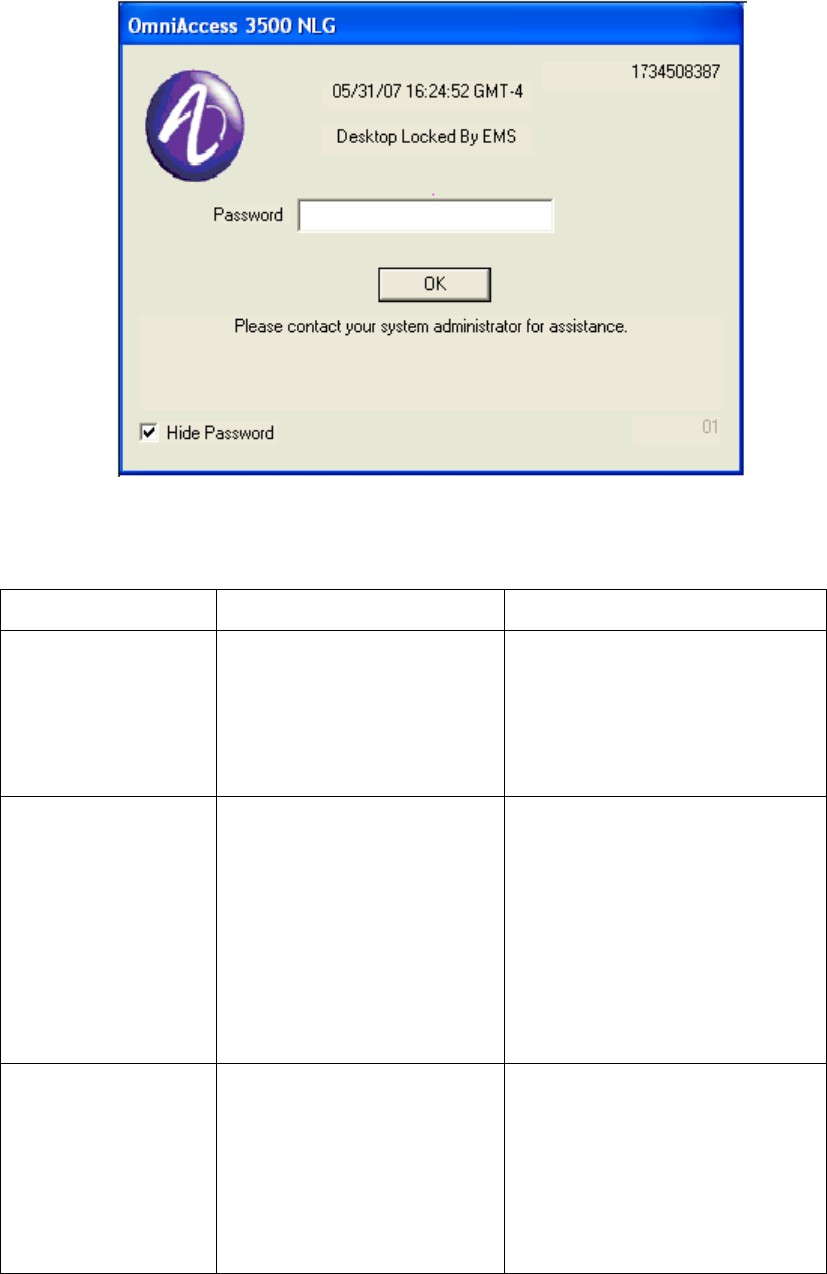
OmniAccess 3500 Nonstop Laptop Guardian End-User Reference Guide
11
The following table shows all possible messages that may appear on the OmniAccess
3500 NLG window when your laptop is locked, the cause of the message, and actions
that you can take to unlock the laptop.
Message Cause Possible actions
Desktop Locked By
IT Administrator The IT administrator has
remotely locked the
laptop.
Contact the administrator to
unlock the laptop. The
administrator can unlock the
laptop remotely, or pass you
a one-time-password (OTP)
over the phone.
Secure Tunnel
Down Laptop is out of 3G range,
or modem power is off, or
otherwise unable to
contact the enterprise
network.
Return within 3G range, or
turn on the modem power, or
connect to a different access
network (Wi-Fi or Ethernet).
-or-
Type in the radio password.
-or-
Contact the administrator to
get an OTP.
Card
Communication
Failed
Laptop is unable to
communicate with the
OmniAccess 3500 NLG
card.
Re-insert the OmniAccess
3500 NLG card
-or-
Remove the card, toggle the
battery switch, and re-insert
the card.
-or-

OmniAccess 3500 Nonstop Laptop Guardian End-User Reference Guide
12
Message Cause Possible actions
Contact the administrator to
get an OTP.
Driver
Configuration Error The network drivers on
the laptop have been
misconfigured.
Contact the administrator to
return the network drivers to
their proper configuration.
-or-
Contact the administrator to
get an OTP.
File Integrity Check
Failed An OmniAccess 3500 NLG
critical file is missing or
corrupt.
Restart the laptop to see if
the OmniAccess 3500 NLG
client software was able to
recover the file.
-or-
Contact the administrator to
get an OTP.
System Integrity
Check Failed An internal check has
failed. Contact the administrator to
get an OTP.
If the laptop is lost with no knowledge of where it could be, the end user should notify
the administrator immediately. The administrator can determine the laptop location
using the GPS capabilities of the OmniAccess 3500 NLG card.
How do I extract the card from my laptop?
Strictly observe the following rules for extraction of the card depending on the power
state of your laptop:
• Power On — You MUST stop the OmniAccess 3500 NLG card device on the Safely
Remove Hardware Windows utility before you physically extract the card from
the CardBus slot in your laptop. Failure to run the Safely Remove Hardware
utility may compromise the future operation of your card and laptop.
• Standby/Hibernate/Power Off — You MAY extract the OmniAccess 3500 NLG card
from the CardBus slot after your laptop enters the Standby, Hibernate, or Power
Off mode. In that case, you MUST always plug the card back into the CardBus slot
before your laptop powers up again. Failure to plug the card back in before
power-up may compromise the future operation of your card and laptop.
How do I get help?
If you need assistance using your OmniAccess 3500 NLG card, please contact customer
support as follows:
Alcatel-Lucent Enterprise Solutions Division
26801 West Agoura Road
Calabasas, CA 91301 USA
E-mail: support@ind.alcatel.com

OmniAccess 3500 Nonstop Laptop Guardian End-User Reference Guide
13
Service & Support Website: http://eservice.ind.alcatel.com/
Phone: 800-995-2696
Technical Specifications
This section presents LED, radio, electrical, environmental, and mechanical
specifications for your OmniAccess 3500 NLG card.
LED Specifications
You find two LED bars (LED A and LED B) on the external end of your OmniAccess 3500
NLG card:
• LED A (3G Modem): The 3G Modem LED is closer to the 3G antenna. The LED can
be in one of the following states:
− Off — 3G modem is off, or no 3G signal is detected.
− Rapid Blinking — 3G signal detected, trying to establish link.
− Slow blinking — 3G link established.
− Random blinking — Transmitting data.
• LED B (OmniAccess 3500 NLG): The OmniAccess 3500 NLG modem is farther
from the antenna. The LED can be in one of the following states:
− Off — Card is off or VPN tunnel is up.
− Solid Red — Card is on and VPN tunnel is down.
Radio Frequency and Electrical Specifications
Approvals Compliant with:
IS-856-A (CDMA 1xEV-DO Revision A)
IS-856 (CDMA 1xEV-DO Release 0)
IS-2000 (CDMA 1xRTT)
IS-95 A/B
IS-707-A Data
IS-637-A SMS
IS-683-A Service Provisioning
IS-683-B (partial)
FCC (ID: RUT-OA3530-S)
Industry Canada (ID: 1737G-OA3530-S)
Data Services
CDMA 1xEV-DO Revision A — DL up to 3.1 Mbps, UL up
to 1.8 Mbps
CDMA 1xEV-DO Release 0 — DL up to 2.4 Mbps, UL up
to 153.6 Kbps

OmniAccess 3500 Nonstop Laptop Guardian End-User Reference Guide
14
CDMA 1xRTT — DL up to 153.6 Kbps, UL up to 153.6
Kbps
Voltage
+3.3 VDC from PCMCIA Slot
Frequency Bands 800 MHz North American Cellular Band
1900 MHz North American PCS Band
GPS Band
Antenna Diversity Rx Diversity in both 800 MHz and 1900 MHz bands
Temperature Operating
Range IS-98D compliance: -30 to +60 °C
Reduced RF performance: +60 to +75 °C
Dimensions
122 mm (L) x 54 mm (W) x 5 mm (H) [15 mm (H) in
extended portion only]
Environmental and Mechanical Specifications
Temperature Operating
Range IS-98D compliance: -30 to +60 °C
Reduced RF performance: +60 to +75 °C
Dimensions
122 mm (L) x 54 mm (W) x 5 mm (H) [15 mm (H) in
extended portion only]
Regulatory Information
This section contains important regulatory notices about your OmniAccess 3500 NLG
card.
Regulatory Notices
The design of the OmniAccess 3500 NLG card complies with U.S. Federal
Communications Commission (FCC) and Industry Canada (IC) guidelines respecting
safety levels of radio frequency (RF) exposure for portable devices, which in turn are
consistent with the following safety standards previously set by Canadian, U.S. and
international standards bodies:
• ANSI / IEEE C95.1-1999, IEEE Standard for Safety Levels with Respect to Human
Exposure to Radio Frequency Electromagnetic Fields, 3kHz to 300 GHz
• National Council on Radiation Protection and Measurements (NCRP) Report 86,
1986, Biological Effects and Exposure Criteria for Radio Frequency
Electromagnetic Fields
• Health Canada, Safety Code 6, 1999, Limits of Human Exposure to Radio
frequency Electromagnetic Fields in the Frequency Range from 3 kHz to 300 GHz
• International Commission on Non-Ionizing Radiation Protection (ICNIRP) 1998,
Guidelines for limiting exposure to time-varying electric, magnetic, and
electromagnetic fields (up to 300 GHz).
FCC ID: RUT-OA3530-S — Industry Canada ID: 1737G-OA3530-S
OmniAccess 3500 Nonstop Laptop Guardian End-User Reference Guide
15
CAUTION: The OmniAccess 3500 NLG card has been tested for compliance with FCC/IC
RF exposure limits in the laptop computer(s) configurations with the side loading PC
Card slot and can be used in laptop computers with substantially similar physical
dimensions, construction, and electrical and RF characteristics. This PC card must not
be co-located or operated in conjunction with any other antenna or transmitter. Use
of this device in any other configuration may exceed the FCC RF Exposure compliance
limit. Note: If this PC Card is intended for use in any other portable device, you are
responsible for separate approval to satisfy the SAR requirements of Part 2.1093 of
FCC rules.
Where appropriate, the use of the equipment is subject to the following conditions:
• WARNING (EMI) — United States FCC Information: This equipment has been
tested and found to comply with the limits for a class B computing device
peripheral, pursuant to Parts 15, 22, and 24 of the FCC Rules. These limits are
designed to provide reasonable protection against harmful interference in a
residential installation.
This equipment generates, uses, and can radiate radio frequency energy and, if
not installed and used in accordance with the instructions, may cause harmful
Section 4B: Regulatory Information 91 interference to radio communication.
However, there is no guarantee that interference will not occur in a particular
installation.
If this equipment does cause harmful interference to radio or television
reception, which can be determined by turning the equipment off and on, the
user is encouraged to try to correct the interference by one or more of the
following measures:
− Reorient or relocate the receiving antenna
− Increase the separation between the equipment and receiver
− Connect the equipment into an outlet on a circuit different from that to
which the receiver is connected
− Consult the dealer or an experienced radio/TV technician for help.
This device complies with Part 15 of the FCC Rules. Operation is subject to the
following two conditions:
− This device may not cause harmful interference, and
− This device must accept any interference received, including interference
that may cause undesirable operations.
FCC guidelines stipulate that the antenna should be more than 1.7 cm from the
user. The highest reported SAR values of the OmniAccess 3500 NLG card by
Alcatel-Lucent are:
− Separation distance of at least 1.7 cm needs to be maintained to user’s lap
with OmniAccess 3500 NLG card inserted into the bottom PC Card slot of
the laptop computer (1.345 mW/g).
CAUTION: Any changes or modifications not expressly approved by Alcatel-Lucent
could void the user’s authority to use the equipment.
OmniAccess 3500 Nonstop Laptop Guardian End-User Reference Guide
16
• WARNING (EMI) — Canada: This digital apparatus does not exceed the Class B
limits for radio noise emissions from digital apparatus as set out in the
interference causing equipment standard entitled “Digital Apparatus,” ICES-003
of the Department of Communications.
Cet appareil numérique respecte les limites de bruits radioélectriques
applicables aux appareils numériques de Classe B prescrites dans la norme sur le
matériel brouilleur: “Appareils Numériques,” NMB-003 édictée par le ministre
des Communications.
If you have purchased this product under a United States Government contract, it
shall be subject to restrictions as set forth in subparagraph (c)(1)(ii) of Defense
Federal Acquisitions Regulations (DFARs) Section 252.227-7013 for Department of
Defense contracts, and as set forth in Federal Acquisitions Regulations (FARs)
Section 52.227-19 for civilian agency contracts or any successor regulations. If
further government regulations apply, it is your responsibility to ensure
compliance with such regulations.
Safety and Notices
This section provides important information about the radio performance and safe use
of your OmniAccess 3500 NLG card.
Important Notice
Because of the nature of wireless communications, transmission and reception of data
can never be guaranteed. Data may be delayed, corrupted (i.e., have errors) or be
totally lost. Although significant delays or losses of data are rare when wireless
devices such as the OmniAccess 3500 NLG card by Alcatel-Lucent are used in a normal
manner with a well-constructed network, they should not be used in situations where
failure to transmit or receive data could result in damage of any kind to the user or
any other party, including but not limited to personal injury, death, or loss of
property. Alcatel-Lucent accepts no responsibility for damages of any kind resulting
from delays or errors in data transmitted or received using the OmniAccess 3500 NLG
card by Alcatel-Lucent, or for failure of the OmniAccess 3500 NLG card by Alcatel-
Lucent to transmit or receive such data.
Safety and Hazards
Do not operate the OmniAccess 3500 NLG card by Alcatel-Lucent in areas where
blasting is in progress, where explosive atmospheres may be present, near medical
equipment, life support equipment, or any equipment which may be susceptible to any
form of radio interference. In such areas, the OmnniAccess 3500 NLG card by Alcatel-
Lucent MUST BE POWERED OFF. It can transmit signals that could interfere with this
equipment.
Do not operate the OmniAccess 3500 NLG card by Alcatel-Lucent in any aircraft,
whether the aircraft is on the ground or in flight. In aircraft, the OmniAccess 3500 NLG
card by Alcatel-Lucent MUST BE POWERED OFF. When operating, it can transmit signals
that could interfere with various onboard systems.
The driver or operator of any vehicle should not operate the OmniAccess 3500 NLG
card by Alcatel-Lucent while in control of a vehicle. Doing so will detract from the
OmniAccess 3500 Nonstop Laptop Guardian End-User Reference Guide
17
driver or operator's control and operation of that vehicle. In some jurisdictions,
operating such communications devices while in control of a vehicle is an offense.